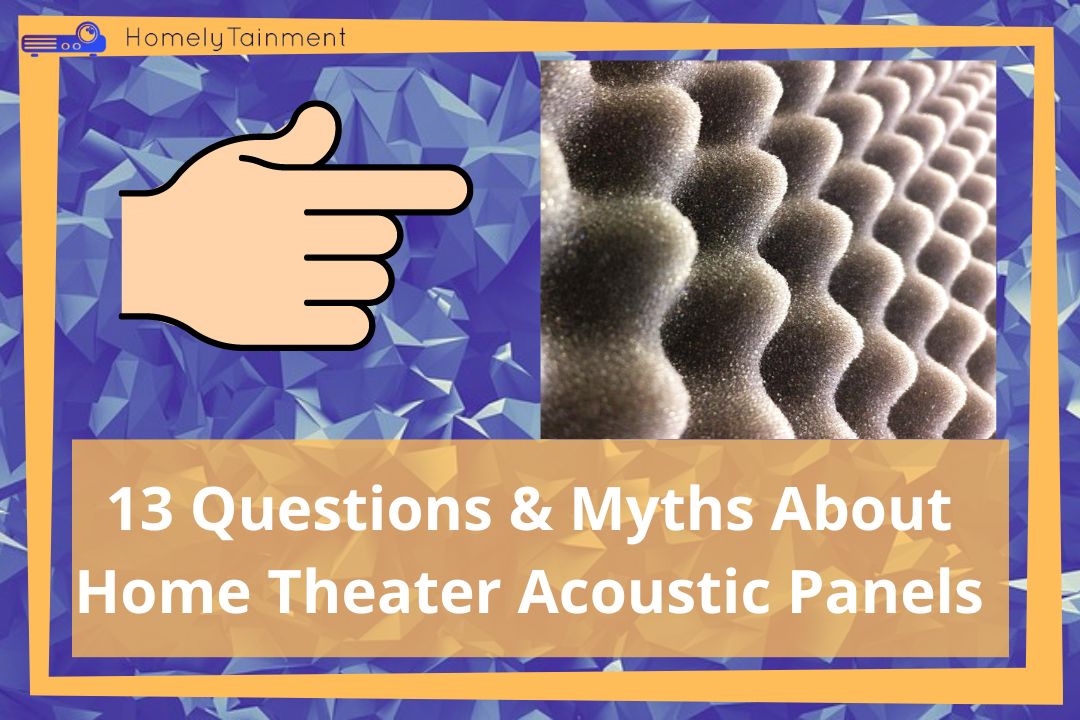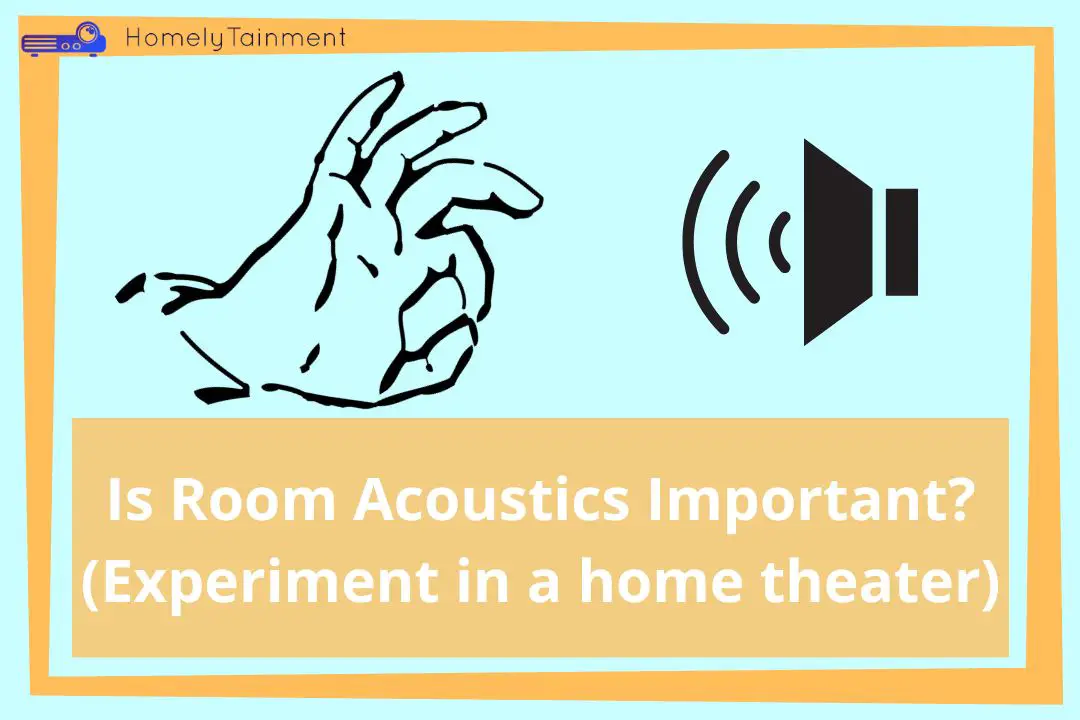
Homelytainment earn commissions (at no additional cost to you) if you purchase products from retailers after clicking on a link from our site.
I was getting emails about the acoustic panels literally daily. I compiled those questions and found the most asked questions.
These were the questions that everyone was asking me. I arrange them in a manner that will clear your confusion about the acoustic panels.
After reading this Q&A till the end you will be a complete expert in the acoustics of the theater room.
These are not only questions but I have explained some myths about the panels too. These myths are very common among newbies.
Instead of emailing the same stuff to every guy. I thought I should write a detailed guide about it and then I will send this guide to everybody’s email and many internet users can read this guide directly on the web.
Let’s start discussing the myths and questions about the panels. These are 13. You can click on the table of content and it will direct you to the question to which you are searching for the answer. Happy reading and learning.
Do acoustic panels reduce sound?
In-Short: The acoustic panel doesn’t reduce the sound overall. It only reduces the reverberations of the sound.
In-Depth: These panels only absorb an excessive amount of sound rays. These rays if not absorbed will reverberate all across the room. These reverberations will confuse your mind. You will start hearing the same dialogue several times at different time intervals.
After panels that absorb these excessive rays. The sound will sound clean and it will be filtered. The actual amount of sound that is hitting your ears will never change, only its reverberation will be reduced.
How many acoustic panels do I need for the home theater?
In-Short: You need one acoustic panel for each reflection point. This means how many reflection points you have in the room and the same amount of panels you will need.
In-Depth: The reflection points are the points where the sound rays will collide and they will bounce back from that point. One beam of sound that will hit your ears is ok but if a lot of them are bouncing back then it is a thing to be worried about.
The acoustic panels need to cover these reflection points. So, it can absorb the other rays or beams of sound.
How to find sound’s first reflection points?
In-Short: To find sound reflection points you don’t need expensive tools. You just need an ordinary mirror. Hold this mirror in your hand and slide it over the walls, floor, and ceiling. The mirror face should be towards you.
In-Depth: Hold a pen in the other hand. Mark the place where you see the reflection of your speakers in the mirror.
You have successfully hunted down each reflection point in your theater room. Now, you have to stick the acoustic panel on each reflection point.
The final verdict to this question is that there is no exact number of panels that I can tell. The number of panels depends on the number of reflection points.
Is 1-inch acoustic foam enough?
In-Short: There is no exact number that is enough. You have to measure the length and width of the reflection point. You will have to install an acoustic panel that will cover the whole reflection point from left to right no matter if it is 1 inch or 5 inches.
In-Depth: The exact number is not enough because that number will work for me but it might not work for you. Because the width and size of the reflection points are heavily affected by the theater room size and the size of the speakers.
How to measure the size of the required acoustic panel? Well, when you have found the reflection point by following my answer to the above question then this one. You will have to slide the mirror from up to down and left to right from this reflection point.
Notice till which point you have noticed the height of that reflection point and the width of it. You will have to install that size of an acoustic panel. That size will be enough for you. That’s why I am hesitant to tell you one exact number for the size of the acoustic panel.
What is the best shape for acoustic foam?
In-Short: The best shape is that which can be arranged in a way that will successfully cover the first reflection points. Don’t pick shapes like circles or ovals because they can’t be arranged in a way that can cover the reflection points.
In-Depth: The most common shapes are triangles, squares, or rectangles and these are best too. These shapes can be arranged in a way that will cover the points.
The worst are circle and oval shapes. These shapes no matter how you arrange them there will always be a blank space between the two panels. If the circle-shaped panel is big enough that it can cover the reflection point by itself. Then it is the best size by itself.
But if it can’t cover the reflection point by itself and requires another panel to do the job together then it is not the best shape but it is the worst because there will be a blank space between these shapes which will boost the sound reverberation.
Do acoustic panels block incoming sound?
In-Short: The acoustic panels can’t block incoming sound. It can’t due to two reasons. The first is that they are not designed to soundproof the room, it only erases the sound reverberation from the theater room and the second reason is that they are installed inside of the room.
In-Depth: The acoustic panels are designed to absorb the extra edges of the sound. They are not designed to soundproof your room. And they are installed inside the room.
Now, you might be thinking that in many cases the soundproofing material is installed inside the room too. Then what about that? They are installed inside but another wall is built in front of the existing room wall then that soundproofing material is sprayed in the blank space between these two walls.
The soundproofing material is inside the room but between the two walls while the acoustic panels are on the surface of the walls. That surface that faces you.
Do acoustic panels keep the sound inside?
In-Short: The acoustic panels can’t keep the sound inside. The sound will still be heard outside of the theater room if the room is not soundproofed and only acoustic panels are installed.
In-Depth: These panels are designed to kill the echo inside the room. It won’t block the sound coming inside or it is going outside.
To keep the sound inside the room. You need to completely soundproof your home theater room. The soundproofing of it will block the incoming sound and will keep the sound of the speakers inside.
This is a misconception that these panels can keep the sound inside.
Do acoustic panels destroy walls?
In-Short: The acoustic panels can’t destroy walls but if the wall paint is not of good quality then it can be destroyed by the adhesive glue or tap through which you have attached the acoustic panels.
In-Depth: The adhesive glue can destroy the paint on the wall if the paint is not of good quality. The panels themselves can’t destroy either the wall or the paint.
Don’t worry you can go for the panels. You will love the sound after installing them. You will fall in love with your home theater after the sound is filtered by these panels.
The clean sound can make the movies feel realistic.
Why do you put acoustic panels behind speakers?
In-Short: The reason that we put the acoustic panels behind the speakers is that the speaker throws out the sound in a circle from every edge of it. The sound that it emits from behind can directly collide with the wall, that’s why the acoustic panel is installed there.
In-Depth: The sound that an ordinary speaker emits is huge and loud. That sound can contribute to the sound reverberation if there are no acoustic panels there.
Why did I say, ordinary speaker? Because the speaker that is built to be mounted on the wall doesn’t require you to install an acoustic panel behind it. Because the engineers have engineered it that way. The intensity of the sound that wall-mountable speakers emit is extremely low. That’s why you don’t need acoustic panels for those.
But if you want to place or mount an ordinary speaker on the wall. Then you need an acoustic panel because those speakers are not designed that way. The intensity of the sound behind them will be high.
How long can acoustic panels last?
In-Short: The acoustic panels last for at least 5 years if the humidity in the room is kept in check. The humidity can destroy the acoustic panels pretty quickly.
In-Depth: Don’t use the humidifiers in the theater room where you have installed the acoustic panels. The panels can last very long even more than 5 years if they are kept away from the humidity in the room.
How much space do you need between acoustic panels?
In-Short: You may or may not need any space between the acoustic panels. The point is to cover the first reflection point of the sound. No matter how many panels it needs. You will have to stick that many panels together. When it is covered then you can go to another point.
In-Depth: If the two panels cover the point then you will keep space between these panels and a new one according to the space between these reflection points.
No matter how small or large the space between these reflection points you have to install panels at that distance. The space between the panels will be decided by the space between the reflection points.
How thick should my acoustic panels be?
In-Short: The acoustic panels should be at least 1.5-2 inches thick and should be dense too. For bass traps, the best size will be 3-4 inches.
In-Depth: We installed the acoustic panels for the mid and high-range frequencies that’s why we need them to be a little thinner and we installed bass traps for the low-end frequencies. That’s why we want the bass traps to be a little thicker than the acoustic panels.
To capture the mid and high frequencies we install acoustic panels on the walls, floor, and ceiling while we use bass traps at the corners to capture the extra bass.
Are acoustic panels better than foam?
In-Short: There is no difference between foam or acoustic panels when using them for acoustics. The only point is that they should be at least 1.5 inches thick and dense to be used for acoustic purposes.
In-Depth: The acoustic panel is foam by itself but is designed a little differently. But despite the design. They both can be used for the acoustics of the room. The main metric that ensures their application is thickness and density.
They should be dense and thick enough that they can absorb extra sound. The final verdict to this question is that there is no one better among them. You can use any of them both for room acoustics.
Can acoustic Panels/Foam catch on fire?
In-Short: The acoustic panels can catch fire from the short circuit in the wire or any other electronic device.
In-Depth: Don’t install acoustic panels near the wires or electronic devices. If you want to still use them near these things. You need to make sure the necessary safety is carried out.
If you need to install it behind the speaker. Make sure the binding posts of the speaker are well insulated and the wires are tucked in tightly. Also, check the skin of the wires too. The sound feels good after installing the panels behind the ordinary speaker but keep the safety in check too.
Check the 8th question’s answer to know why I used the word “ordinary speaker” here.
Helpful Resources For The FAQs To Read More
- To know how acoustic panels work. Read my this guide. Where to install acoustic panels in the home theater? (Resource for the first answer)
- Read this guide on how to increase the speaker’s clarity. I have discussed a few more things in this guide about speaker clarity. (Resource for the second answer)
- Read this guide, on how to make speakers warmer. I have talked about both free and paid methods in this guide. (Resource for the fourth answer)
- If you want to learn about the soundproofing of a home theater in detail. Then read my guide. (Resource for the sixth answer)
- Read this guide to know how to optimize home theater audio. I have presented the top 5 steps to do that. (Resource for the seventh answer)
- Read this guide to increase home theater bass. I have included 9 steps to perfection. (Resource for the ninth answer)
- This guy has tested it. The test is done by lighter which is more intense than the short circuit but you can get an idea. (Below video Resource for the fourteenth answer)




